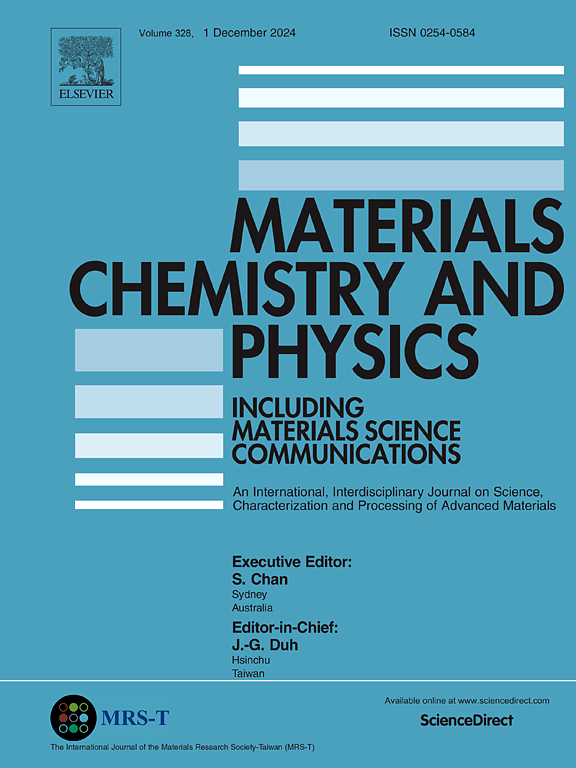掺入聚氨酯涂层的异相氧化铜/铜/铁纳米粒子用于抗导管引起的感染
IF 4.3
3区 材料科学
Q2 MATERIALS SCIENCE, MULTIDISCIPLINARY
引用次数: 0
摘要
为了防止医疗器械表面生物膜的形成,我们开发了一种基于聚氨酯的新型涂层,其中填充了异相纳米粒子 CuO/Cu/Fe。由于纳米粒子成分的协同抗菌作用,所获得的涂层显示出卓越的抗菌活性。因此,含 5% 或更多重量 CuO/Cu/Fe 纳米粒子的涂层对金黄色葡萄球菌、布曼氏杆菌、肺炎双球菌和绿脓杆菌的抗菌率至少为 99.99%。这种涂层的表面能值最大,表明其疏水性增强。导尿管样本的使用寿命超过 30 天,超过了标准导尿管的使用寿命。根据所获得的结果,应用所开发的涂层是解决导尿管相关尿路感染问题的一种可行策略。利用对毒性高度敏感的 3T3 成纤维细胞进行体外培养,确定了该涂层具有良好的生物相容性。与导尿管表面改性的其他策略相比,使用含有复杂成分的纳米颗粒的聚氨酯涂层具有许多优点:由于各种成分的协同作用,纳米颗粒具有很高的抗菌活性;由于使用了生物金属,涂层具有生物相容性;由于涂层与标准硅Foley导尿管具有良好的粘附性,因此使用寿命长。因此,含有纳米粒子的涂层能有效防止导管或其他植入物上的细菌定植,从而降低术后导管引发感染的风险。本文章由计算机程序翻译,如有差异,请以英文原文为准。
Heterophase CuO/Cu/Fe nanoparticle incorporated polyurethane coating for combating catheter-induced infection
To combat biofilm formation on the surface of medical devices, a new coatings based on polyurethane filled with heterophase nanoparticles CuO/Cu/Fe composition have been developed. Due to the synergistic antibacterial effect of the nanoparticle constituents, the obtained coatings demonstrated exceptional antibacterial activity. Thus the coating containing 5 % wt. or more of the CuO/Cu/Fe nanoparticles was at least 99.99 % against bacteria S. aureus, A. bumannii, K. pneumonia, P. aeruginosa. For this coating, the value of surface energy was maximum, indicating an increase in its hydrophobicity. The operational life of the catheter samples was more than 30 days, which exceeds the operational life of standard urinary catheters. Based on the results obtained, the application of the developed coating is a promising strategy for solving the catheter-associated urinary tract infection problem. Good biocompatibility was determined in vitro using 3T3 fibroblast cell culture, which is highly sensitive to toxic effects. Compared to other strategies of catheter surface modification, the use of polyurethane coating with nanoparticles of complex composition has a number of advantages: high antibacterial activity of nanoparticles due to the synergistic effect of constituents; biocompatibility of the coating provided by the use of biometals; long-term service life due to good adhesion of the coating to the standard silicon Foley catheter. Thus, the proposed coating containing nanoparticles effectively prevents bacterial colonization on catheters or other implants, thereby reducing the risk of postoperative catheter-induced infection.
求助全文
通过发布文献求助,成功后即可免费获取论文全文。
去求助
来源期刊

Materials Chemistry and Physics
工程技术-材料科学:综合
CiteScore
8.70
自引率
4.30%
发文量
1515
审稿时长
69 days
期刊介绍:
Materials Chemistry and Physics is devoted to short communications, full-length research papers and feature articles on interrelationships among structure, properties, processing and performance of materials. The Editors welcome manuscripts on thin films, surface and interface science, materials degradation and reliability, metallurgy, semiconductors and optoelectronic materials, fine ceramics, magnetics, superconductors, specialty polymers, nano-materials and composite materials.
 求助内容:
求助内容: 应助结果提醒方式:
应助结果提醒方式:


